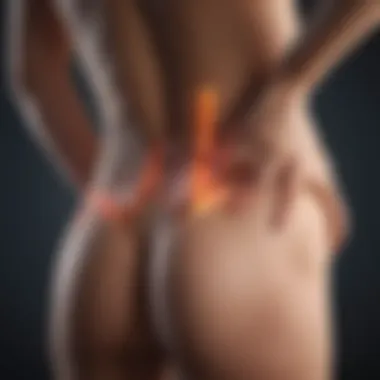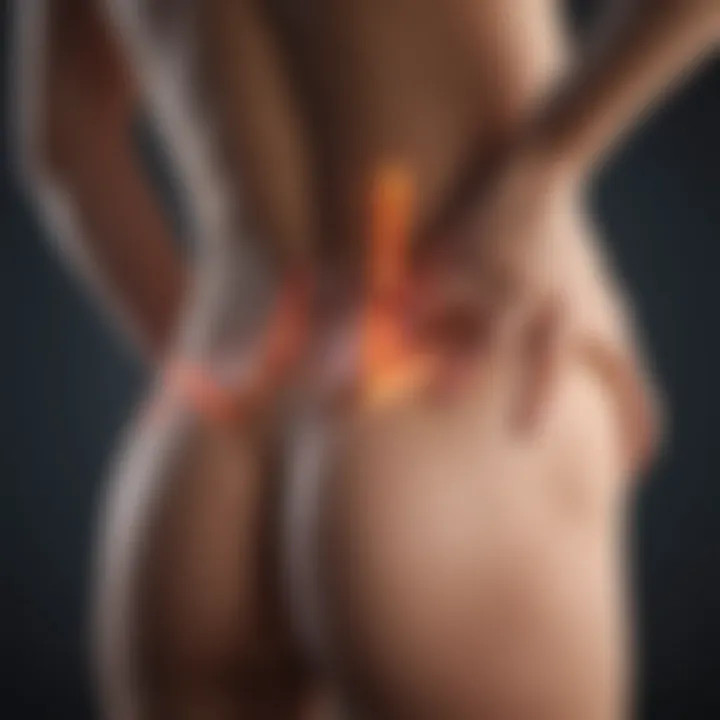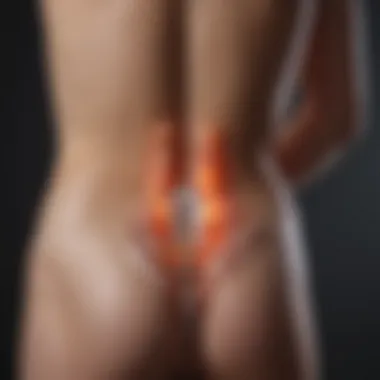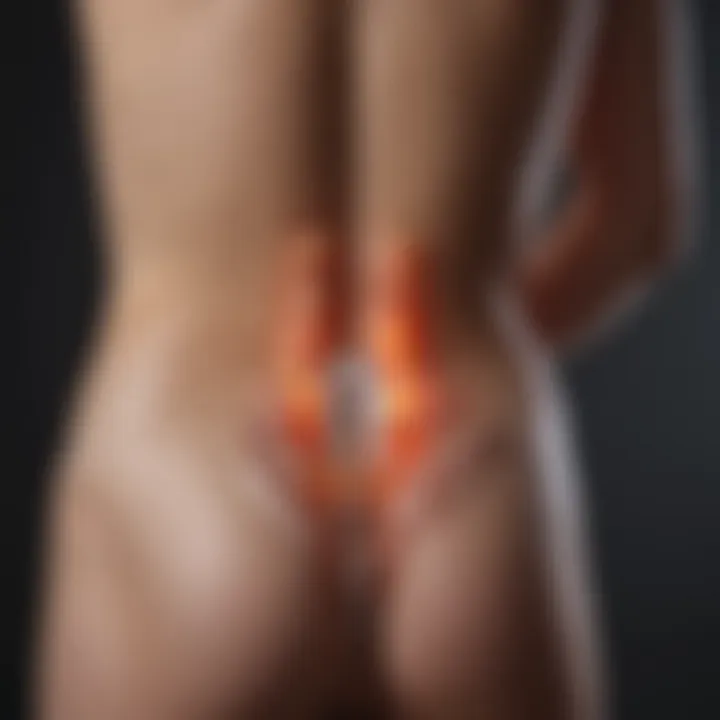Understanding the Complexities of Lower Back Pain


Summary of Objectives
The key objective of this article is to provide a well-rounded understanding of lower back pain. It seeks to inform readers about its causes, diagnostic techniques, treatment alternatives, and preventive strategies. By highlighting these topics, the article aims to equip readers with substantial knowledge that can contribute to better management practices.
Importance of the Research
This research into lower back pain is relevant to various stakeholders, including health practitioners, educators, and patients. Given the high prevalence of this condition, data from this exploration can directly affect management strategies and educational frameworks surrounding back health. Improved understanding can lead to more effective interventions and can ultimately enhance the quality of life for those affected.
Results and Discussion
Presentation of Findings
Lower back pain arises from a myriad of factors, including:
- Physiological Issues: This encompasses anatomical abnormalities, disc degeneration, and muscular strain.
- Psychological Factors: Stress and anxiety can exacerbate perceptions of pain or lead to chronic pain conditions.
- Lifestyle Choices: Sedentary behavior, poor posture, and improper lifting techniques contribute significantly to the prevalence of lower back discomfort.
These findings underline the necessity for multifaceted approaches in both the diagnosis and treatment of lower back pain. For instance, combining physical therapy with psychological support can yield better patient outcomes.
Implications of Results
The implications of these findings are profound.
- On Healthcare Providers: Practitioners may need to adopt a multi-disciplinary approach to manage lower back pain effectively.
- For Patients: Increased awareness of the contributing lifestyle factors may promote proactive engagement in preventive strategies.
"Understanding the complexities of lower back pain requires an interdisciplinary approach that incorporates physiological, psychological, and lifestyle factors."
Understanding Lower Back Pain
Understanding lower back pain is crucial due to its widespread impact on the population. It affects individuals across all ages and backgrounds, influencing daily activities, productivity, and overall quality of life. This section aims to clarify the nature of lower back pain, its prevalence in society, and the underlying anatomy that contributes to this condition.
An accurate understanding of lower back pain can lead to timely interventions. Identifying the characteristics and causes can enhance diagnostic accuracy and guide effective treatment strategies. This knowledge serves not only for those currently suffering from this condition but also for healthcare professionals, educators, and researchers focused on improving patient outcomes.
Definition and Prevalence
Lower back pain, often referred to as lumbago, is a condition characterized by discomfort or pain in the lower spine and surrounding areas. It can arise from various factors, including muscle strain, injury, or underlying health issues. Globally, statistics suggest that approximately 80% of individuals will experience lower back pain at some point in their lives, making it one of the most common medical complaints. This high prevalence emphasizes the need for comprehensive understanding and effective management strategies.
Anatomy of the Lower Back
The anatomy of the lower back encompasses several critical components that play a vital role in its function and vulnerability to pain. Understanding these elements allows for better insights into the causes and implications of lower back pain.
Vertebrae
Vertebrae are the individual bones that stack together to form the spine. Specifically, the lumbar vertebrae, which comprise five vertebrae in the lower back, support much of the body's weight and enable flexibility. Their unique structure, characterized by larger bodies compared to other spinal vertebrae, provides essential strength. However, this design also makes them susceptible to injury and degenerative changes, particularly in the presence of factors like age and physical stress.
Intervertebral Discs
Intervertebral discs act as cushions between the vertebrae. They are composed of a tough outer layer and a gel-like center that provides flexibility and shock absorption. These discs are pivotal in allowing movement while preventing the vertebrae from grinding against each other. An important feature of intervertebral discs is their limited blood supply, which can affect their healing capacity when injured. Degeneration or injury to these discs, such as herniation, can lead to significant pain and discomfort, highlighting their critical role in spinal health.
Nerves and Muscles
Nerves and muscles work together to support movement and stability of the lower back. The spinal nerves exit the vertebrae to transmit signals between the brain and the body, while the muscles surrounding the spine assist in its movement. The balance between these muscles is crucial; strong muscles can protect the spine, while weakened muscles can lead to instability and pain.
Understanding the interplay of nerves and muscles in the lower back is essential for both treatment and prevention of pain.
The anatomy of the lower back plays a significant role in an individual’s health. By grasping its complexities, one can gain valuable insight into the multifaceted nature of lower back pain.
Etiology of Lower Back Pain
Understanding the etiology of lower back pain is vital for many reasons. It helps in identifying the underlying causes, which in turn aids in developing effective management strategies. This section examines different types of pain and common causes that play a significant role in this condition.
Acute vs. Chronic Pain
Lower back pain can be classified into two main categories: acute pain and chronic pain. Acute pain typically lasts for a short duration, usually less than six weeks. It often follows an injury, strain, or specific activity. Patients may experience sudden sharp pain that may limit mobility. On the other hand, chronic pain persists for longer than three months and may develop gradually. Chronic lower back pain can significantly impact a person's daily life and emotional well-being, often requiring a multi-faceted approach for management. Both types have different implications for treatment and recovery.
Common Causes
Muscle Strain
Muscle strain is a common contributor to lower back pain. It occurs when muscles and ligaments in the back are overstretched or torn. This usually results from heavy lifting, awkward movements, or sudden changes in activity. One key characteristic of muscle strain is its relatively quick recovery time, which makes it a popular point of discussion in this article. The unique feature of muscle strain lies in its temporal nature; symptoms may resolve on their own given time and rest. However, returning to activity too soon can lead to more serious injury, indicating caution is necessary in recovery plans.


Herniated Discs
Herniated discs occur when the soft material between vertebrae bulges out or ruptures, pressing on nearby nerves. This condition often leads to intense pain, tingling, or numbness. A pivotal aspect of herniated discs is their potential for chronic pain, making it a critical area of focus in this article. The unique aspect of this condition is its complexity; while some herniated discs might be asymptomatic, others can necessitate surgical intervention if conservative measures fail. Therefore, understanding this condition is key for any comprehensive approach to lower back pain management.
Degenerative Disc Disease
Degenerative disc disease is associated with the natural aging process of the spine, where discs lose hydration and elasticity. This leads to reduced cushioning between vertebrae, causing pain. The key feature of this condition is its progressive nature, typically leading to increasingly severe discomfort over time. It ranks as a significant concern for longevity and overall quality of life. Knowing the implications of degenerative changes in the vertebrae is essential for practitioners dealing with long-term back pain cases.
Other Medical Conditions
Other medical conditions that may cause or contribute to lower back pain include arthritis, scoliosis, and kidney stones. Each of these has distinct mechanisms that can lead to discomfort in the lower back. For example, arthritis leads to inflammation in the joints, causing pain and stiffness. The key characteristic of these conditions is their diversity, which reflects the multifaceted nature of lower back pain. Recognizing that factors outside of simple muscle strains can contribute to pain is crucial for effective diagnosis and treatment.
Understanding the etiology of lower back pain is pivotal for implementation of appropriate treatment strategies and optimizing patient outcomes.
Symptoms Associated with Lower Back Pain
Understanding the symptoms associated with lower back pain is crucial for both identifying the condition and implementing effective management strategies. Recognizing these symptoms helps in guiding proper treatment and improving the overall quality of life for individuals affected. A detailed analysis of these symptoms can reveal patterns that provide insight into the underlying causes of the pain. This section examines two critical aspects of symptoms: pain characteristics and functional limitations.
Pain Characteristics
Location of Pain
The location of pain in the lower back is a significant indicator of the underlying issue. Pain may be centralized, occurring over the lumbar region, or it may radiate down to the legs, indicating possible nerve involvement. One key characteristic of pain location is its ability to hint at the nature of the injury or condition. For example, pain that is isolated to one side might suggest a herniated disc, while bilateral pain could indicate muscular strain or spinal stenosis.
Understanding where pain is felt assists healthcare professionals in narrowing down potential diagnoses. This specificity is beneficial because it allows for a more targeted approach in treatment options. The unique feature of this characteristic is its ability to provide early red flags about more serious conditions, such as sciatica or fractures.
Intensity and Duration
The intensity and duration of lower back pain are equally important for a comprehensive understanding. Intensity can range from a dull ache to sharp, debilitating pain, providing insight into the severity of the condition. Duration plays a pivotal role in categorizing pain into acute or chronic. Acute pain lasts for a short duration, frequently resulting from an injury, while chronic pain persists for more than three months and can be more challenging to treat. This categorization is a key characteristic in determining the right treatment plan.
Furthermore, the unique aspect of intensity is its dynamic nature; it can fluctuate based on activity levels, sleep quality, and even emotional state. Noting these variations helps create a more informative pain profile, leading to better management strategies.
Functional Limitations
Functional limitations refer to the impact that lower back pain has on daily activities. Individuals may find it difficult to perform routine tasks such as bending, lifting, or even sitting for long periods. These limitations are crucial as they can directly affect one’s quality of life. For many, the inability to engage in work or recreational activities may lead to feelings of frustration and decreased well-being.
Understanding these limitations helps healthcare providers design targeted rehabilitation plans that can include exercises or lifestyle modifications to improve functional ability. Recognizing how pain manifests in functionality is essential for fostering autonomy and independence in patients.
Diagnostic Approaches
Understanding the diagnostic approaches for lower back pain is essential in guiding treatment and management strategies. Accurate diagnosis facilitates the identification of underlying issues, allowing for tailored interventions that can alleviate pain and improve quality of life. The process generally encompasses clinical evaluations and the use of various imaging techniques. Each approach offers unique insights, thereby enhancing the overall understanding of the individual's condition.
Clinical Evaluation
Clinical evaluation serves as the first step in diagnosing lower back pain. This process typically begins with a detailed patient history, where the physician gathers information about the onset, nature, and duration of pain. Factors such as previous injuries, lifestyle habits, and other medical conditions are also considered. A physical examination follows, aimed at assessing the range of motion, muscle strength, and any neurological deficits.
During the evaluation, a practitioner may ask specific questions to comprehend the pain's impact on daily activities. This comprehensive assessment helps in identifying any red flags indicative of serious underlying conditions. Conditions such as fractures, infections, or tumors require immediate attention and may warrant further diagnostic procedures.
Diagnostic Imaging
Imaging techniques play a crucial role in the diagnosis of lower back pain. They provide visual insights into the structural and functional aspects of the spine, aiding clinicians in developing effective treatment plans.
X-rays
X-rays are one of the most commonly used imaging modalities. They help to view the bone structure of the spine. A key characteristic of X-rays is their ability to quickly reveal bone fractures or alignment issues. This makes them a beneficial choice when urgent results are needed. However, X-rays do not visualize soft tissues, such as muscles or ligaments, which can be a limitation. They are effective for diagnosing bone-related issues but may not provide a complete picture of the underlying causes of pain.
MRIs
Magnetic Resonance Imaging, or MRI, is another important imaging tool that offers detailed images of both bones and soft tissues. A key characteristic of MRIs is their capacity to detect issues such as herniated discs, nerve compression, and other soft tissue abnormalities. Because MRIs do not use ionizing radiation, they are a popular choice for evaluating lower back pain, especially in patients with recurring or persistent symptoms. Despite their advantages, MRIs can be expensive and take longer to obtain compared to X-rays.
CT Scans
Computed Tomography (CT) scans combine the advantages of X-rays and MRI, providing detailed cross-sectional images of the spine and surrounding structures. A notable feature of CT scans is their ability to assess both bony and soft tissue abnormalities. They are particularly effective in evaluating complex spinal conditions, such as fractures or tumors. However, due to their exposure to radiation and higher costs, their use is typically reserved for situations where detailed imaging is crucial.
Understanding the appropriate diagnostic approach is vital for effective treatment of lower back pain. Accurate imaging and clinical evaluation guide proper management and improve patient outcomes.
In summary, diagnostic approaches for lower back pain involve a careful balance between clinical evaluations and various imaging techniques. Each method plays a complementary role in identifying the cause of pain, guiding treatment strategies, and enhancing patient quality of life.
Treatment Options for Lower Back Pain


The treatment options for lower back pain are essential to understand for anyone experiencing this condition. These options vary widely, catering to different causes and severities of pain. A comprehensive grasp of available treatments allows both patients and practitioners to formulate a strategic plan, aiming for effective relief. Understanding these options not only fosters informed decision-making but also empowers individuals in managing their health.
Conservative Treatments
Conservative treatments are often the first line of defense against lower back pain. They are generally non-invasive and aim to alleviate symptoms while promoting recovery.
Physical Therapy
Physical therapy plays a crucial role in treating lower back pain. It focuses on strengthening muscles, improving flexibility, and enhancing overall physical function. The key characteristic of physical therapy is its individualized approach, tailoring exercises to a patient’s specific needs. This personalization increases healing potential and overall effectiveness of the treatment.
The unique feature of physical therapy lies in its holistic nature; it not only addresses pain but also focuses on preventing future injuries. One significant advantage is that it empowers individuals to take an active role in their recovery. However, it can require a considerable time commitment and may not provide immediate relief, which some patients seek.
Chiropractic Manipulation
Chiropractic manipulation is another conservative treatment gaining popularity among those with lower back pain. This method focuses primarily on spinal alignment and mobilization of the joints. A key characteristic of chiropractic manipulation is its emphasis on hands-on adjustments. Chiropractors aim to restore proper function, which may result in significant pain relief.
A unique feature of chiropractic care is that it often emphasizes overall wellness rather than simply managing symptoms. This approach can be beneficial for long-term health. However, patients should be aware that not all conditions may respond favorably to chiropractic care. As with any treatment, there are potential risks and it is vital to consult with healthcare providers.
Medication
Medication is frequently used to manage lower back pain, especially in cases where symptoms are severe or chronic. Over-the-counter options like ibuprofen and acetaminophen can provide immediate relief and are widely accessible. A key characteristic of medication is its ability to target pain directly through various mechanisms. Certain medications may reduce inflammation, providing symptomatic relief to patients. Advantages of medication include rapid effect and ease of use, making it a convenient choice for many. However, reliance on medication can lead to potential side effects and issues such as tolerance or dependency. Long-term use should be approached cautiously, with discussions between patients and healthcare providers regarding the risks vs benefits.
Surgical Interventions
There are circumstances when conservative treatments may not sufficiently alleviate lower back pain, necessitating surgical intervention. Understanding indications for surgery can clarify when this serious option should be considered.
Indications for Surgery
Indications for surgery often involve structural problems that conservative treatments have failed to address. Common indications include persistent pain, neurological deficits, or progressive weakness. A key characteristic of indications for surgery is that they are based on the impact of back pain on a patient’s daily life and functionality. Surgery may be seen as a beneficial solution when quality of life is significantly impaired. A unique feature of surgical indications is the focus on long-term outcomes. Surgery may offer a more permanent solution in cases such as herniated discs or severe spinal stenosis. However, surgery carries its own risks and may not guarantee relief. Therefore, a thorough evaluation by a healthcare professional is essential before proceeding.
Types of Surgical Procedures
There are several types of surgical procedures available for lower back pain. Common options include discectomy, spinal fusion, and laminectomy. A key characteristic of these procedures is that they aim to remove or correct structures causing pain. Each type of surgery has specific applications based on the underlying cause of pain. The unique aspect of surgical procedures lies in their targeted nature. For example, a discectomy specifically addresses herniated discs by removing the portion applying pressure on nerves. Advantages include potentially rapid relief compared to conservative treatments. Disadvantages, however, include recovery time and the possibility of not achieving the desired outcome.
In essence, the treatment options for lower back pain range from conservative to surgical, with careful consideration needed for each approach. It is essential for patients to discuss their options thoroughly with their healthcare providers to ensure an informed decision is made.
Preventive Measures
Preventive measures are key to managing lower back pain effectively. Addressing this issue before it develops into a chronic condition can save individuals from significant discomfort and potential long-term disability. This section focuses on various lifestyle modifications and ergonomic practices that can significantly reduce the risk of developing lower back pain.
Lifestyle Modifications
Exercise and Conditioning
Regular exercise is a cornerstone of maintaining a healthy back. Engaging in activities such as walking, swimming, and strength training helps enhance muscle strength, endurance, and flexibility. This is crucial because strong muscles provide support for the spine, which can help alleviate and prevent strain. Key characteristics of exercise for back health include the ability to strengthen the core muscles, which stabilize the spine.
The unique feature of exercise and conditioning is its accessibility. Many individuals can perform exercises at home or in local gyms with minimal equipment. However, it is important to note that not all exercise is beneficial. High-impact activities or improper techniques can lead to injury and exacerbate existing pain. Therefore, one should choose activities that align with their physical capabilities.
Posture Correction
Posture correction plays a vital role in preventing lower back pain. Poor posture can lead to abnormal load distribution on the spine, which increases the risk of strain and injury. Key characteristics of good posture include maintaining a neutral spine, keeping shoulders relaxed and back, and ensuring that the head is aligned over the shoulders. By developing awareness of body positioning, individuals can mitigate stress on the lower back.
A unique aspect of posture correction is that it can often be achieved through simple adjustments. For example, ensuring that computer screens are at eye level can prevent slouching. While the positive impact of improving posture is significant, it requires consistent effort and mindfulness, which can be challenging to maintain.
Weight Management
Maintaining a healthy weight is crucial in the fight against lower back pain. Excess weight increases the load on the spine, which can lead to pain and injury. The key characteristic of effective weight management is balancing caloric intake with physical activity. A thoughtful approach to diet and exercise can facilitate achieving a healthy weight.
One unique feature of weight management as a preventive measure is its holistic nature. It not only helps reduce back pain but can also lead to improvements in overall health metrics, such as cardiovascular fitness. However, weight management requires commitment and can sometimes be a slow process, which can discourage individuals looking for immediate relief.
Ergonomics in Daily Life
Ergonomics is the science of designing the workspace to fit the user. By employing ergonomic practices, individuals can significantly reduce the likelihood of experiencing lower back pain. Common ergonomic adjustments can include using a chair that supports the lumbar region, arranging workstations to minimize awkward postures, and utilizing tools designed to reduce strain. Such practices are often simple to implement but can have a profound impact on comfort and health.
Investing in ergonomic furniture and tools not only protects the back but also enhances productivity.
Cumulatively, these preventive measures can significantly impact the management and mitigation of lower back pain, underscoring the importance of taking proactive steps in daily life.
Psychosocial Factors
Psychosocial factors play a significant role in the experience of lower back pain. This area encompasses emotional, social, and environmental influences that can affect an individual’s perception of pain and their ability to cope with it. Understanding these factors is critical, as they can greatly impact not only the pain one experiences but also the effectiveness of treatment options. The interaction between psychological well-being and physical health can create a feedback loop, where pain leads to stress and anxiety, further exacerbating the discomfort.
Impact of Stress and Anxiety


Stress and anxiety are closely linked to the experience of lower back pain. Often, individuals dealing with chronic pain also face high levels of stress, which can intensify their perception of pain. The body responds to stress with muscle tension and a heightened state of alertness, which may contribute to discomfort in the lower back area. Additionally, anxiety can lead to avoidance behaviors, such as physical inactivity, which might worsen the condition over time. Understanding this connection is essential for both patients and practitioners, as addressing stress and anxiety might not only alleviate emotional burdens but also positively impact physical symptoms.
Coping Strategies
Coping strategies are approaches that individuals can use to manage pain and deal with associated stress. Two effective strategies are Mindfulness Techniques and Cognitive Behavioral Strategies, each offering unique benefits.
Mindfulness Techniques
Mindfulness techniques train individuals to focus on the present moment without judgment. This practice can reduce negative thoughts and emotional responses related to pain. One key characteristic of mindfulness is its emphasis on awareness of bodily sensations, which can help individuals recognize when they are tense and consciously relax. This simplicity makes mindfulness a popular choice in the management of lower back pain. The unique feature of mindfulness is its non-invasive approach; it does not rely on medication, thus providing a strong alternative for those wary of pharmaceutical options. However, some individuals may find it challenging to maintain focus initially, which could limit its effectiveness at first.
Cognitive Behavioral Strategies
Cognitive Behavioral Strategies (CBT) offer another method for managing lower back pain. CBT focuses on changing the thought patterns that contribute to the perception of pain. A core characteristic of CBT is its structured approach, which includes specific techniques for challenge and reframe negative thinking. This makes CBT a beneficial approach for individuals who struggle with negative self-talk, as it provides tools for constructive thinking about pain. The unique feature of CBT lies in its evidence-based nature; numerous studies have shown its effectiveness in chronic pain management. However, CBT may require more time and effort to learn and implement, which might be a barrier for some individuals.
Effective management of lower back pain should consider not only physical aspects but also psychosocial factors that influence pain perception.
In summary, addressing psychosocial factors like stress and anxiety can significantly enhance overall outcomes for individuals dealing with lower back pain. Implementing coping strategies such as mindfulness and cognitive behavioral techniques can empower individuals to manage their pain more effectively.
Impact on Quality of Life
Lower back pain poses profound challenges that affect numerous aspects of daily life. Quality of life encompasses physical, emotional, and social well-being, and lower back pain can compromise all these elements. Patients often experience physical limitations due to pain, reducing their ability to engage in activities they once enjoyed. This decline can lead to a cycle of inactivity, further complicating their condition.
Physical Functionality
The physical implications of lower back pain are significant. Individuals may find it challenging to perform simple tasks, like bending, lifting, or standing for long periods. As a result, everyday activities, including work obligations and household chores, become arduous. A decline in physical functionality often triggers a reliance on medication. Some may turn to stronger prescriptions, which may have adverse effects in the long run. Furthermore, persistent pain can lead to a decrease in physical fitness, resulting in a higher risk of conditions like obesity, heart disease, and diabetes. Maintaining good physical health is closely tied to reducing the adverse effects of lower back pain, and thus, managing pain is essential to improve physical functionality.
Emotional and Psychological Well-being
The emotional toll of lower back pain is equally important. Chronic pain can lead to feelings of frustration, anger, and helplessness, frequently resulting in mood disorders like depression and anxiety. The continuous cycle of pain can affect sleep quality, leading to insomnia and a poor overall sense of well-being. Social relationships can suffer as well. Individuals may isolate themselves from friends and family due to discomfort or embarrassment about their condition.
Emotional support is crucial in coping with lower back pain. Engaging in support groups or therapy can help individuals process their feelings and maintain a more positive outlook. Cognitive behavioral strategies can arm them with tools to manage their thoughts and emotions regarding their pain. Recognizing the psychological impact of lower back pain is vital for developing a holistic approach to its management.
"Quality of life is not merely the absence of pain but the presence of functionality and emotional resilience."
In summary, lower back pain affects physical functionality and emotional health, intertwining these aspects closely. Addressing both is essential for improving the overall quality of life. Effective management of lower back pain should, therefore, consider not just the physical symptoms but the broader psychological implications as well.
Future Directions in Research
Research into lower back pain is crucial for enhancing understanding and improving treatment options. As our knowledge evolves, so do the strategies we employ to address this prevalent condition. Exploring new therapeutic avenues can significantly impact patient outcomes and quality of life.
Emerging Treatment Modalities
The field of treatment for lower back pain is constantly changing. New methods are being developed that may improve patient care significantly. Some of these emerging treatment modalities include:
- Regenerative Medicine: Techniques such as platelet-rich plasma (PRP) therapy and stem cell treatments are gaining traction. These methods aim to heal damaged tissues and potentially reverse degenerative changes in the spine.
- Non-Pharmacological Interventions: Acupuncture and other complementary therapies are being increasingly researched for their effectiveness. Evidence suggests that they can provide pain relief and improve functionality without the side effects associated with traditional medications.
- Personalized Medicine: Advances in genetic research may allow for tailoring treatment plans to individual patients. Understanding how one's genetic makeup influences pain perception can lead to more effective, customized interventions. This approach could maximize benefits while minimizing adverse effects.
The exploration of these modalities could offer newer and better ways to manage lower back pain.
Understanding Pain Mechanisms
The complexity of pain mechanisms warrants detailed investigation. Pain perception is influenced by multiple factors and varies greatly among individuals. Key areas of focus include:
- Neuropathic Pain: Research is delving into conditions where nerve damage is the primary issue. Identifying these pathways could lead to targeted treatments that alleviate neuropathic symptoms effectively.
- Biopsychosocial Model: Understanding how biological, psychological, and social factors converge to affect pain can inform treatment strategies. It emphasizes the need for a holistic approach to pain management, considering each patient's unique circumstances.
- Neuroplasticity: The brain's ability to adapt and change could be harnessed through therapeutic techniques. By fostering positive neural adaptations, it may be possible to reduce chronic pain perception.
Research in these areas is vital. A deeper comprehension of pain mechanisms paves the way for revolutionary advancements in treatment practices, ultimately fostering a better quality of life for those affected by lower back pain.
"Understanding the underlying mechanisms of pain is essential for developing effective strategies to manage it."
Closure
The conclusion of this article emphasizes the critical role of understanding lower back pain in both clinical practice and everyday life. This section illustrates how encompassing various aspects—from etiology to treatment—can significantly impact patient management and quality of life. Recognizing that lower back pain is multifaceted is essential. More than just a physical ailment, it can have profound psychosocial implications. By addressing all these domains, healthcare professionals can provide a more holistic approach to treatment.
The insights gathered underscore the importance of early intervention and preventive strategies. When individuals understand the risk factors and treatment options available, they are better equipped to manage their conditions. Additionally, fostering awareness around lifestyle modifications can lead to improved patient outcomes.
Summary of Key Points
- Lower back pain represents a common yet complex issue affecting many individuals globally.
- Multiple causes include physical, psychological, and lifestyle factors.
- Accurate diagnosis requires comprehensive clinical evaluation and often the use of diagnostic imaging.
- Treatment approaches range from conservative methods, such as physical therapy, to surgical interventions when necessary.
- Prevention can be achieved through lifestyle changes and ergonomic adjustments.
- Psychosocial factors significantly influence both pain perception and recovery.
- Ongoing research is vital to unravel the complexities of pain mechanisms and refine treatment modalities.
Call for Continued Research
The call for continued research in the field of lower back pain is paramount. Emphasis should be placed on exploring emerging treatment modalities. With advances in technology and a deeper understanding of pain mechanisms, new strategies can improve patient outcomes.
Researchers need to focus on integrating findings from various disciplines, such as psychology and physiology. A better understanding of the interplay between these factors can lead to more effective pain management strategies.
Furthermore, longitudinal studies are necessary to evaluate the long-term effectiveness of current treatments. This ongoing research not only benefits individual patients but also contributes to clinical guidelines and public health policies aimed at reducing the burden of lower back pain on society.
"Continued investment in research is crucial to understand and manage lower back pain effectively, benefiting patients and healthcare systems alike."















